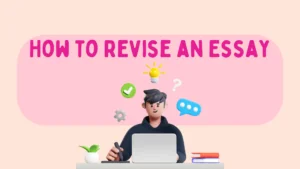Writing a well-structured essay is like building a house: you need a solid foundation, sturdy walls, and a roof to complete it. A well-organized essay helps your ideas flow smoothly and makes it easier for readers to follow your argument. Plus, it shows that you’ve put thought into your work, making it more convincing and enjoyable to read.

✅ AI Essay Writer ✅ AI Detector ✅ Plagchecker ✅ Paraphraser
✅ Summarizer ✅ Citation Generator
So, what does a good essay structure look like? Whether you’re writing a narrative, descriptive, expository, or persuasive essay, following this structure will help you stay organized and make your writing more impactful. Let’s dive in and learn how to put it all together!
How to Structure an Essay
Imagine you’re building a house. You need a solid foundation, walls, and a roof to make it stand. Writing an essay is similar. It requires a good structure to hold your ideas together and make your argument clear. Let’s break down the go-to essay structure to help you get started.
First, you need an introduction that grabs the reader’s attention. Start with an engaging opening sentence that makes your reader want to keep going. This could be a surprising fact, a question, or a bold statement. Then, provide some background information to set the context or give a brief overview of the topic. Finally, end your introduction with a thesis statement that clearly presents the main argument or purpose of your essay.
Next, you have the body paragraphs. Each paragraph should begin with a topic sentence that introduces the main idea. Follow this with supporting details, which can be evidence, examples, or explanations that back up your point. It’s important to keep your ideas clear and logical. Also, use transitions to smoothly link each paragraph to the next, helping the reader follow your argument effortlessly.
Lastly, your conclusion ties everything together. Start by restating your thesis in different words to reinforce your main argument. Then, summarize the key points you discussed in the body paragraphs. This helps remind the reader of the journey they’ve taken through your essay. Finally, end with a closing statement or call to action that leaves a lasting impression. This could be a thought-provoking comment, a suggestion for further research, or a call to action based on your argument.
Remember, the introduction sets the stage, the body paragraphs build the argument, and the conclusion wraps it all up.
With practice, you’ll find that this go-to structure makes essay writing much easier and more effective.
Basic Essay Structure for Different Types of Essays
Writing essays becomes simpler when you understand the structure. Here, we’ll look at five common types: narrative, descriptive, expository, persuasive, and comparative essays. Each has unique characteristics and serves a specific purpose. I’ll also include an example of how to structure the main body for each type.
Narrative Essay
A narrative essay tells a story from the author’s perspective. It aims to engage the reader by making the story interesting and relatable.
| Key Characteristics | Description |
|---|---|
| Point of View | First person (“I”) or third person (“he,” “she”) |
| Plot | A clear sequence of events |
| Characters | Well-developed individuals involved in the story |
| Setting | Descriptions of where and when the story takes place |
| Theme | The underlying message or lesson |
Example Structure:
- Introduction: Set the scene and introduce the main character.
- Body Paragraph 1: Describe the beginning of the story (setting, characters).
- Body Paragraph 2: Describe the main event or conflict.
- Body Paragraph 3: Describe the climax of the story.
- Conclusion: Describe the resolution and the lesson learned.
Descriptive Essay
A descriptive essay paints a picture with words. It aims to describe a person, place, object, or event so vividly that the reader can visualize it.
| Key Characteristics | Description |
|---|---|
| Sensory Details | Use of the five senses: sight, sound, smell, touch, taste |
| Vivid Language | Descriptive adjectives and adverbs |
| Organization | Can be organized spatially, chronologically, or by importance |
| Imagery | Creating mental images through detailed descriptions |
| Subject Focus | Detailed focus on the subject being described |
Example Structure:
- Introduction: Introduce the subject you will describe.
- Body Paragraph 1: Describe the subject using sight (what it looks like).
- Body Paragraph 2: Describe the subject using sound (what it sounds like).
- Body Paragraph 3: Describe the subject using smell, touch, and taste (if applicable).
- Conclusion: Summarize the main points and highlight the overall impression.
Expository Essay
An expository essay explains or informs. It provides a balanced analysis of a topic, using facts, statistics, and examples.
| Key Characteristics | Description |
|---|---|
| Clear Thesis | A specific statement or argument the essay supports |
| Evidence | Facts, statistics, and examples |
| Logical Organization | Introduction, body paragraphs each with a main idea, and a conclusion |
| Neutral Tone | Objective and impartial |
| Explanation | Detailed explanation of the topic |
Example Structure:
- Introduction: Present the topic and state the thesis.
- Body Paragraph 1: Explain the first main idea with supporting facts and examples.
- Body Paragraph 2: Explain the second main idea with supporting facts and examples.
- Body Paragraph 3: Explain the third main idea with supporting facts and examples.
- Conclusion: Summarize the main points and restate the thesis.
Persuasive Essay
A persuasive essay aims to convince the reader to accept a particular viewpoint or take a specific action. It uses logic, reason, and emotion to build a compelling argument.
| Key Characteristics | Description |
|---|---|
| Clear Position | A definite stance on an issue |
| Supporting Arguments | Logical reasons to support the position |
| Evidence | Facts, statistics, expert opinions, and examples |
| Counterarguments | Addressing opposing views and refuting them |
| Emotional Appeals | Using persuasive language to elicit emotions from the reader |
Example Structure:
- Introduction: Introduce the topic and state your position.
- Body Paragraph 1: Present the first supporting argument with evidence.
- Body Paragraph 2: Present the second supporting argument with evidence.
- Body Paragraph 3: Present the third supporting argument with evidence.
- Body Paragraph 4: Address a counterargument and refute it.
- Conclusion: Summarize the arguments and reinforce your position.
Comparative Essay
A comparative essay examines the similarities and differences between two or more subjects. It helps the reader understand the subjects better by comparing them.
| Key Characteristics | Description |
|---|---|
| Comparison Basis | Clear criteria for comparison |
| Subjects | Two or more subjects being compared |
| Organizational Structure | Point-by-point or block method |
| Thesis Statement | Indicates the purpose and scope of the comparison |
| Analysis | Detailed examination of similarities and differences |
Example Structure:
- Introduction: Introduce the subjects and state the basis for comparison.
- Body Paragraph 1: Compare the first point of similarity or difference between the subjects.
- Body Paragraph 2: Compare the second point of similarity or difference between the subjects.
- Body Paragraph 3: Compare the third point of similarity or difference between the subjects.
- Conclusion: Summarize the comparisons and highlight the overall insights.
Now, you can effectively organize your essays and make your writing clear and engaging. Each type of essay has its unique features, so choose the one that best fits your topic and purpose.
How to Organize an Essay with Structural Transition Words
Using transitional words is like putting up road signs for your reader. These words guide them through your essay, making it easier to follow your thoughts and arguments. They help in creating a smooth flow, making your writing more engaging and coherent. Let’s dive into different types of transitional words and how they can be used effectively.
👋 Introduction to Body
When you transition from the introduction to the body of your essay, you need words that signal the beginning of your main discussion. These words help to seamlessly connect the introduction to the detailed points you will cover.
For instance, words like “Firstly,” “To begin with,” and “Initially” are perfect for starting your body paragraphs. They let the reader know that you are moving from the introductory context to the main points. For example, you might say, “Firstly, it’s important to understand the historical context of the issue.” Or, “To begin with, let’s explore the primary causes of the conflict.” These words set the stage for detailed analysis and help the reader transition smoothly from the general introduction to specific arguments.
➕ Adding Information
When you need to add more information or points to your argument, transitional words come in handy. These words indicate that there is more to say on the topic, building on what has already been mentioned.
Words like “Furthermore,” “Moreover,” and “Additionally” are great for adding information. For example, “Furthermore, recent studies support this claim,” or “Moreover, this approach has been widely adopted in several countries.” By using these words, you show that you are expanding on your previous points, making your argument more comprehensive and convincing.
✅ Providing Examples
To illustrate your points more clearly, providing examples is absolutely necessary. Transitional words help introduce these examples smoothly, showing the reader that you are giving concrete evidence to support your claims.
Examples of such words include “For example,” “For instance,” and “Such as.” You might write, “For example, many schools have implemented this program successfully,” or “For instance, in the case of renewable energy, solar power has shown remarkable potential.” These words prepare the reader for specific details that back up your general statements, making your argument stronger.
☀️❄️ Contrasting Information
Sometimes, you need to present contrasting information to show different perspectives or to highlight an exception to the rule. Transitional words help indicate a shift from one idea to a contrasting one.
Words like “However,” “On the other hand,” and “Conversely” are ideal for this purpose. For example, “However, not all experts agree with this view,” or “On the other hand, there are significant challenges to this approach.” These words signal to the reader that you are about to present a different angle, helping them to understand the complexity of the issue.
🔀 Showing Cause and Effect
To explain the relationship between actions and outcomes, cause-and-effect transitional words are essential. They help you link causes to their effects clearly and logically.
Words such as “Therefore,” “Consequently,” and “As a result” are perfect for this. You might say, “Therefore, it is clear that immediate action is necessary,” or “Consequently, the policy had to be revised.” These words make it easy for the reader to follow the logical progression of your argument, showing how one idea leads to another.
📍 Summarizing/Concluding
In the conclusion of your essay, you need transitional words that help you summarize your main points and bring your argument to a close. These words signal to the reader that you are wrapping up your discussion.
Examples include “In conclusion,” “To summarize,” and “Ultimately.” For example, “In conclusion, the evidence strongly supports the need for policy change,” or “To summarize, the key factors influencing this issue have been thoroughly examined.” These words help you succinctly tie together your main points and leave the reader with a clear understanding of your argument.
Tips for Writing a Structure of an Essay
Writing a well-structured essay is like building a strong bridge that connects your ideas seamlessly. Let’s dive into some tips that can help you create a clear and effective essay structure.

Think of an outline as your essay’s roadmap. Before you start writing, take some time to outline your main points. This will give you a clear direction and keep you on track. Start with your introduction, list out the key points you’ll cover in the body, and jot down ideas for your conclusion. Outlining helps you organize your thoughts and makes the writing process smoother.

Each paragraph in your essay should focus on one main idea. Begin with a topic sentence that clearly states this idea. The rest of the paragraph should provide evidence, examples, or explanations that support the topic sentence. This keeps your writing focused and makes it easier for the reader to follow your argument. For example, if you’re writing about the benefits of exercise, one paragraph might focus on physical health benefits, while another might discuss mental health improvements.

Transitions are the glue that holds your essay together. They help you move smoothly from one idea to the next, ensuring your essay flows well. Words like “Firstly,” “Additionally,” “However,” and “In conclusion” guide your reader through your essay. These transitions make your writing more coherent and help emphasize the relationships between your ideas.

A well-balanced essay is easy to read and understand. Make sure your paragraphs are roughly the same length and provide a balanced amount of information. Avoid cramming too much information into one paragraph or making another too short. Each paragraph should be clear, focused, and contribute to your overall argument. This balance keeps your essay well-organized and engaging.

Once you’ve finished writing, take the time to proofread your essay. Look for structural consistency: Are your paragraphs in a logical order? Do your transitions make sense? Is each paragraph focused on a single main idea? Proofreading helps you catch any inconsistencies or areas that might confuse your reader. It’s also a good time to check for clarity. Make sure your ideas are clearly expressed and easy to understand.
Writing a structured essay doesn’t have to be complicated. By outlining your essay, ensuring each paragraph has a clear main idea, using transitions, keeping paragraphs balanced, and proofreading for consistency and clarity, you can create an essay that is both engaging and easy to follow. Practice these tips, and you’ll become more confident in your essay writing skills. Happy writing!
FAQ
Follow us on Reddit for more insights and updates.





Comments (0)
Welcome to A*Help comments!
We’re all about debate and discussion at A*Help.
We value the diverse opinions of users, so you may find points of view that you don’t agree with. And that’s cool. However, there are certain things we’re not OK with: attempts to manipulate our data in any way, for example, or the posting of discriminative, offensive, hateful, or disparaging material.